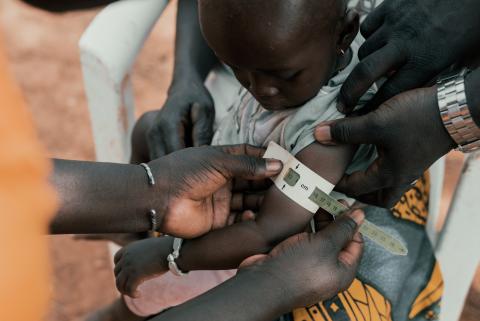Food vouchers for moderate acute malnutrition: Evidence from Northern Cameroon
This is a summary of the following paper: Teta I, Foudjo B, Nielsen J et al. (2023) Outcomes of a food voucher program and factors associated with the recovery rate of children with moderate acute malnutrition in far north Cameroon. Journal of Health, Population and Nutrition, 42, 37. https://jhpn.biomedcentral.com/articles/10.1186/s41043-023-00379-1
Moderate wasting remains prevalent around the world but receives less research attention than severe wasting. This quasi-experimental study investigated the effects of a food voucher programme on overall recovery rates in eligible children in a rural, agricultural area within northern Cameroon. This was a longitudinal cohort study that defined recovery as a mid-upper arm circumference (MUAC) >125mm. Moderate wasting was defined as between ≥115mm and ≤125mm (Box 1).
Overall, 28,292 children aged 6–59 months were flagged by community health workers, with 2,126 then confirmed as moderately wasted by health centres.1 Of these children, 333 were included in the study, which was conducted between January and August 2020. Children were excluded if they were severely wasted, severely ill, or if they refused to participate.
The intervention involved a CFA 8,000 (USD 15) voucher that could be redeemed for a standardised basket of food defined using NutVal2 software. The food basket was designed to provide adequate nutrients in combination with the existing diet, plus a small surplus to accommodate intra-household food sharing.
The overall recovery rate of enrolled children was 78.3%, with a significant increase in MUAC over time (p<.001). Unfortunately, 10.5% (n=50) deteriorated into severe wasting, 3.4% remained moderately wasted post-intervention, and 7.2% were lost to follow-up. Over half the children (56.1%) were recovered at the first of six visits.
The minimum sample size, based on the researchers’ calculation (n=456), was not reached for this study so there is an increased likelihood of both false negative and false positive results. Although these results are significant, they may be unreliable. Taking previous studies into account and given the high recovery rate, there nevertheless appears to be value in this intervention. However, determining whether this is the most efficacious or cost-effective intervention requires additional research.
The use of a quasi-experimental design – without a comparison group – is a limitation, although there was no standardised moderate wasting treatment in this setting to compare against, so this study design was necessary. There was also no follow-up beyond the study period, so we are unable to determine whether children relapsed at a later point. Given the number of children who opted out of the study, with only 15.6% of the eligible population included, it is likely that selection bias was present. The researchers do provide descriptive statistics for the study population, which is a strength, but we cannot infer whether the population is representative without reference data for the broader area.
Box 1: A note on cut-offsMUAC cut-offs are defined and applied in a variety of ways based on the programme or implementing agency. As cut-offs are an artificial point on a spectrum of malnutrition, they are limited as they do not always correlate to morbidity and/or mortality, which are the truly important measures when considering recovery rates. However, they are necessary as they allow programme resources to be prioritised to those most at risk. In this study, the cut-off for moderate wasting is in line with current World Health Organization guidelines. |
1 Those with severe wasting were treated according to government protocols in a separate programme.
2 https://www.unscn.org/en/resource-center/archive/methods-tools-and-indicators?idnews=1463


